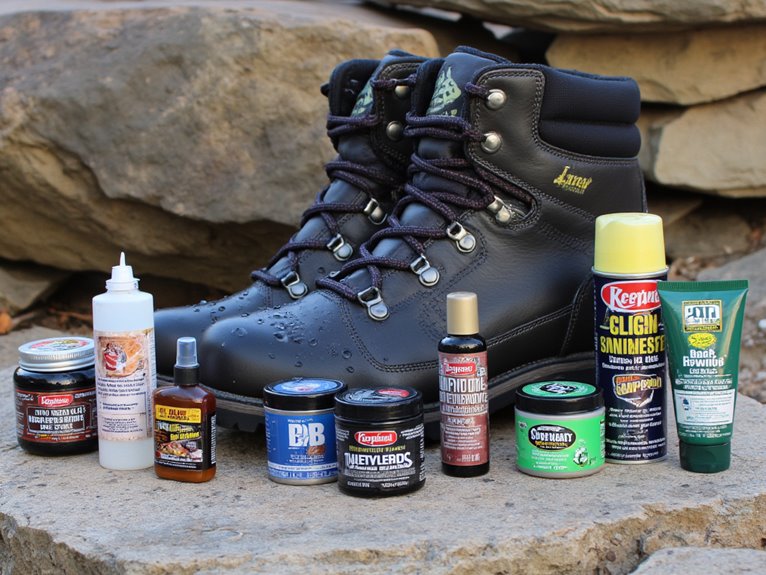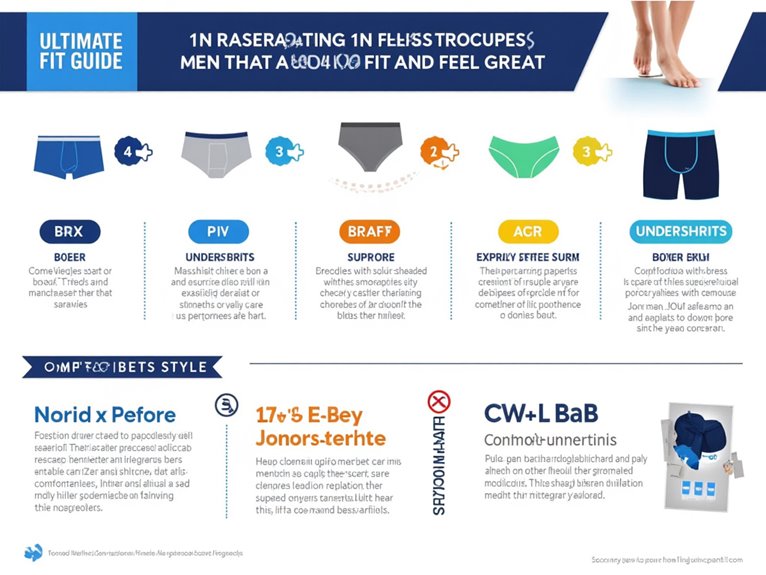What Is a Sleeping Bag Baffle
A sleeping bag baffle is a fabric compartment that prevents your insulation from shifting and creating cold spots while you sleep. You’ll find two main types: stitched-through baffles, which are lighter but create thermal bridges, and boxwall baffles, which use vertical fabric walls to eliminate cold spots and maintain consistent loft. These compartments keep down or synthetic fill properly distributed around your body, ensuring ideal thermal performance in varying conditions. Understanding baffle construction helps you choose the right system for your specific camping needs.
We are supported by our audience. When you purchase through links on our site, we may earn an affiliate commission, at no extra cost for you. Learn more. Last update on 4th December 2025 / Images from Amazon Product Advertising API.
Notable Insights
- Baffles are internal compartments in sleeping bags that hold and organize insulation material to prevent shifting during sleep.
- They eliminate cold spots by maintaining consistent insulation distribution and preventing heat loss through thermal bridging.
- Two main types exist: stitched-through baffles (budget-friendly but create cold spots) and boxwall baffles (better insulation, more expensive).
- Baffles maintain insulation loft around critical body areas like torso and legs for optimal warmth retention.
- Advanced baffle designs include trapezoidal and V-shaped configurations that maximize down loft and improve thermal efficiency.
Understanding Baffle Construction and Design
When you examine a sleeping bag’s internal structure, baffles serve as the foundation that determines its thermal performance. These compartments contain insulation and prevent shifting that compromises warmth retention.
Baffles form the structural backbone of sleeping bags, creating insulation compartments that prevent heat-robbing material migration in cold conditions.
Baffle craftsmanship directly impacts your bag’s effectiveness in cold conditions. Manufacturers use lightweight fabrics to minimize weight while maintaining structural integrity. Common shapes include trapezoids and boxes, each optimized for specific insulation types and temperature ranges.
The construction method affects insulation efficiency considerably. Stitch-through techniques cost less but create thermal bridges that allow heat loss. Box wall construction uses separate materials to eliminate cold spots. Vertical walls keep down properly distributed throughout each chamber.
Proper baffle design requires precise manufacturing tolerances. Height, offset spacing, and material selection influence down loft and air-trapping capacity, ultimately determining your bag’s warmth-to-weight ratio. Strategic body mapping techniques allow manufacturers to place increased down quantities in critical areas like the torso and foot box while reducing insulation in less essential zones. Effective baffles allow insulation to achieve full loft, maximizing the air pockets that provide superior thermal protection. Different sleeping bags utilize insulation types like down and polyester that behave uniquely within baffle systems and affect overall thermal performance.
Types of Baffle Systems in Sleeping Bags

When you’re selecting a sleeping bag, you’ll encounter two primary baffle system categories that determine how insulation is contained and distributed throughout the bag.
Stitched through systems represent the simplest construction method, where the inner and outer shell fabrics are sewn directly together, creating compartments that eliminate thermal bridging but also create cold spots at stitch lines.
Advanced boxwall designs use fabric walls or mesh panels to create three-dimensional chambers between the inner and outer shells, allowing insulation to loft fully while preventing migration and maintaining consistent warmth distribution. Among the various boxwall configurations available, V-tube construction is recognized as the most efficient baffle design for maximizing thermal performance. These baffle seams are strategically positioned to keep insulation in place and minimize cold spots throughout the sleeping bag.
Stitched Through Systems
Stitched-through systems represent the most basic and widely used baffle construction method in sleeping bag manufacturing. These stitching techniques directly connect the outer shell to the inner lining, creating simple chambers for down insulation.
You’ll find this design in most budget-friendly sleeping bags due to its cost-effective production process.
The construction involves minimal fabric and straightforward manufacturing steps. However, this simplicity comes with trade-offs. Heat loss occurs at each stitch line, creating potential cold spots that reduce thermal efficiency.
Down migration within chambers can cause uneven insulation distribution, compromising your warmth. The horizontal stripes you see on down sleeping bags visually indicate where these baffles separate the insulation chambers.
These insulation strategies work adequately for moderate conditions but struggle in extreme cold. The lack of sidewalls restricts down lofting around baffle edges, limiting insulation performance. While you’ll benefit from lighter weight and lower costs, you’ll sacrifice thermal performance compared to advanced baffle systems like boxwall or V-baffles.
Advanced Boxwall Designs
While stitched-through systems dominate budget sleeping bags, advanced boxwall designs represent the pinnacle of thermal engineering in premium outdoor gear.
These three-dimensional chambers maximize down loft and create uniform distribution throughout your bag.
Trapezoid boxwall construction eliminates cold spots by allowing down to fully expand between fabric walls.
You’ll experience superior heat retention compared to sewn-through alternatives.
Modern baffle innovations include radial arc systems that naturally curve around your body, reducing fabric distortion and thermal bridges. The chevron style baffle design maintains down position for optimized warmth while using less fabric compared to traditional horizontal baffles.
Advanced materials enhance performance considerably:
- Anti-Gravity Nylon fabric weighs just 21g/m² while maintaining downproof integrity
- High-thread count weaves exceed 520 threads per square inch
- Boxfoot designs create insulation layers around foot sections
- Vertical box-wall baffles optimize warmth-to-weight ratios
- Cross Block Baffles maintain optimal down distribution and insulation
These innovations deliver exceptional thermal efficiency for serious outdoor enthusiasts demanding maximum performance.
Stitched Through vs. Boxwall Baffle Construction
When you’re choosing between sleeping bag baffle systems, you’ll encounter two primary construction methods that greatly impact performance.
Stitched through baffles create simple sewn-through chambers where fabric connects the inner and outer shell directly, while boxwall baffles use vertical fabric sidewalls to create three-dimensional chambers.
These construction differences directly affect heat retention, overall weight, and manufacturing complexity—factors that’ll determine your bag’s performance in the field. Box baffles are warmer and heavier compared to simpler stitched-through designs, making them better suited for cold weather conditions.
Construction Method Differences
The method used to connect a sleeping bag’s inner and outer fabric layers fundamentally determines its thermal performance and weight characteristics.
You’ll encounter two primary construction approaches that represent significant baffle innovations in modern gear design.
Stitched through construction pierces both fabric layers directly, creating the simplest manufacturing process. This method produces lighter bags but creates cold spots at every stitch point where insulation gets compressed.
Boxwall construction uses perpendicular fabric panels between layers, forming true 3D chambers. These insulation advancements require more complex manufacturing but eliminate cold spots by preventing down compression at connection points. Advanced techniques like trapezoid construction have become popular in high-end sleeping bags because they effectively balance warmth retention with weight considerations.
Key construction differences include:
- Manufacturing complexity: Stitched through uses simple assembly; boxwall requires precise panel placement
- Material requirements: Boxwall needs additional fabric panels and increased labor time
- Thermal efficiency: Boxwall maintains consistent loft; stitched through creates thermal bridges
- Weight impact: Stitched through prioritizes ultralight design; boxwall emphasizes warmth retention
Heat Loss Comparison
Heat escapes through different pathways depending on your sleeping bag’s baffle construction, creating measurable performance differences between stitched-through and boxwall designs.
Stitched-through baffles create direct thermal bridges where stitching penetrates both inner and outer layers. These stitch lines appear as cold spots in thermal imaging tests, reducing baffle efficiency through conduction heat loss.
Boxwall baffles eliminate most stitch-related thermal bridging by preventing direct fabric-to-fabric contact between inner and outer shells. The side wall barrier maintains insulation performance by allowing down to maintain full loft without compression.
Wind penetration decreases remarkably with boxwall construction since there’s no direct path through the insulation layer. Laboratory EN 13537 tests show minimal seam leakage impact, but real-world field testing consistently demonstrates superior comfort with boxwall designs in cold and windy conditions.
Weight and Complexity
Weight penalties accompany every design choice in sleeping bag construction, making the trade-off between thermal performance and pack weight a critical decision point.
Stitched through baffles deliver the lightest option, requiring minimal fabric and simple sewing techniques. You’ll sacrifice baffle efficiency for this weight advantage, as direct stitching creates thermal bridges that compromise insulation durability over time.
Boxwall construction adds 10-30% more weight due to sidewall fabric requirements and increased manufacturing complexity. However, you gain superior insulation durability through better down distribution and enhanced baffle efficiency.
Key construction differences include:
- Manufacturing complexity increases greatly with boxwall systems
- Labor costs rise due to precise alignment requirements
- Pattern versatility expands with boxwall designs
- Down migration prevention improves considerably
How Baffles Prevent Down Migration and Cold Spots
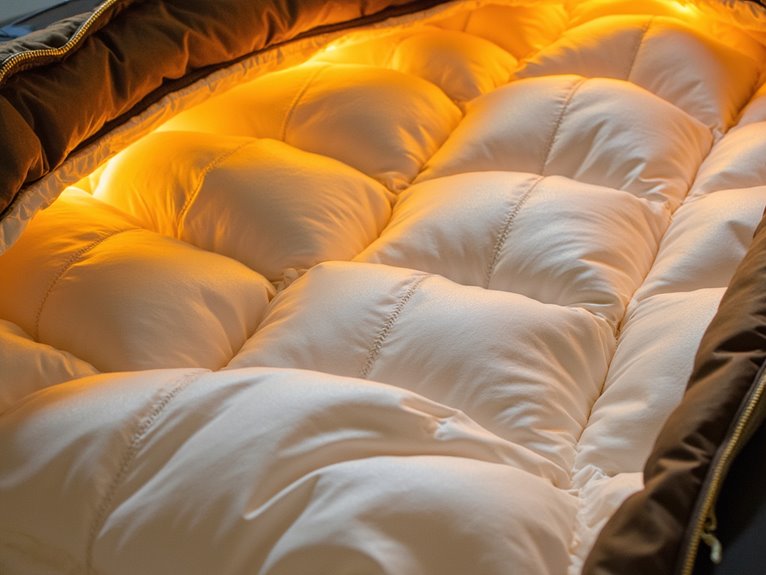
When you’re lying in your sleeping bag on a cold night, baffles work as internal walls that compartmentalize insulation and prevent it from shifting away from your body. This baffle functionality guarantees down stays distributed evenly rather than migrating to the bag’s bottom where gravity naturally pulls it.
Box-wall baffles create vertical chambers that maintain insulation loft around your torso and legs. Side block baffles prevent down from moving between top and bottom sections, eliminating cold spots along your sides.
Without proper baffle construction, you’d experience significant heat loss through compressed areas where insulation has migrated away.
The spacing between baffles directly affects insulation efficiency. Closer baffle spacing provides better down control but adds weight, while wider spacing reduces weight but allows more migration potential.
High-quality baffles work best with 600+ fill power down insulation to maximize warmth retention in extreme cold conditions.
V-Baffles and Trapezoid Baffle Configurations
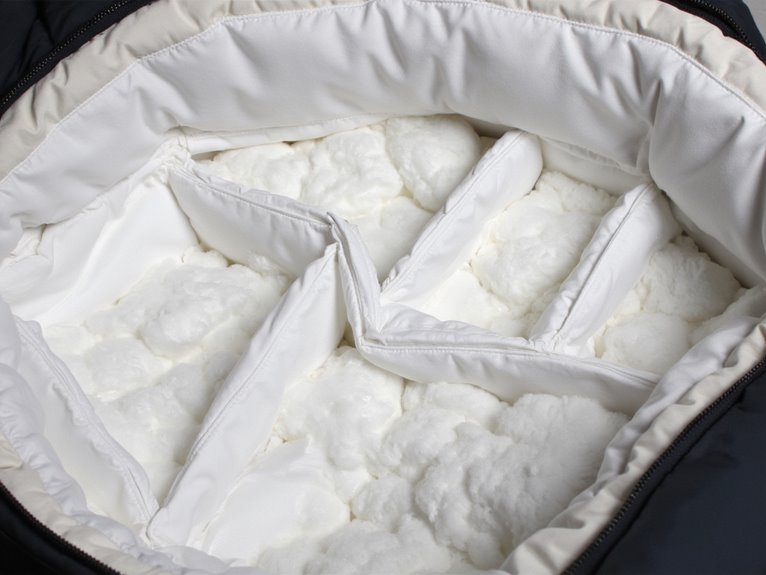
While traditional box-wall baffles create rectangular chambers, V-baffles and trapezoid configurations offer advanced solutions that maximize thermal efficiency through innovative chamber geometries.
V-baffle benefits include superior down migration control through slanted wall construction. The triangular chambers create multiple insulation pockets within the same space, increasing loft retention. You’ll experience enhanced warmth-to-weight ratios, though these designs add slight weight due to additional baffle material.
Trapezoid advantages emerge from offset internal mesh positioning, creating angled chambers that enhance insulation distribution. The horizontal mesh displacement forms chambers that prevent down clumping while maintaining consistent loft.
Key features of advanced baffle configurations:
- V-shaped chambers reduce thermal bridging through geometric design
- Trapezoidal baffles allow customizable chamber sizing for specific temperature ratings
- Both configurations require precise manufacturing techniques for peak performance
- Enhanced insulation efficiency compared to standard rectangular chambers
Brick Baffle Patterns for Enhanced Insulation
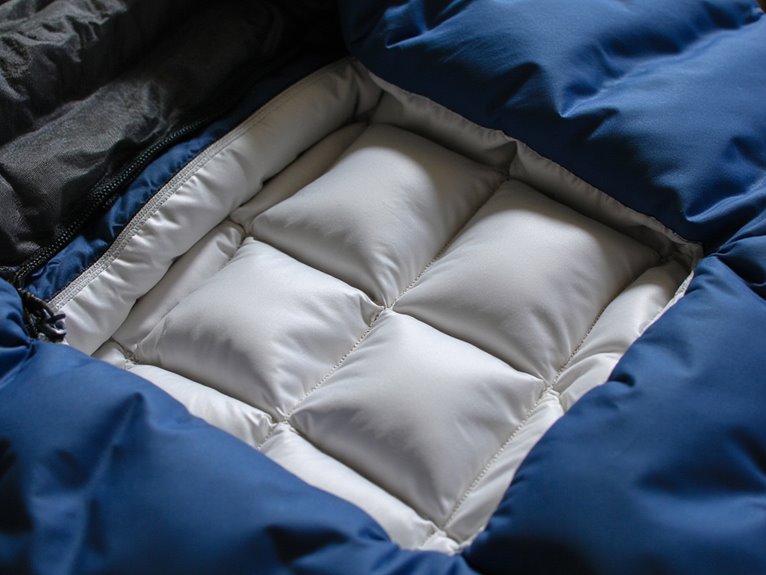
When you’re facing extreme cold conditions, brick baffle patterns offer a sophisticated dual-layer design that combines two offset boxwall configurations to minimize thermal bridging.
This engineering approach creates superior insulation distribution compared to single-layer systems by preventing cold spots where outer and inner fabric layers might otherwise create direct heat transfer paths.
You’ll find this construction delivers an ideal balance between warmth-to-weight performance and manufacturing costs, making it the preferred choice for expedition-grade sleeping bags rated for sub-zero temperatures.
Brick Pattern Design
Brick pattern baffle design represents a significant advancement in sleeping bag insulation technology, employing a staggered baffle arrangement that mimics traditional brickwork construction.
This method minimizes thermal bridging by offsetting baffle seams between layers. You’ll find this design prevents down migration while maintaining consistent loft distribution throughout the bag.
The brick advantages include superior heat retention through reduced cold spots and enhanced down utilization efficiency.
However, construction challenges involve increased manufacturing complexity and higher production costs compared to simple stitched-through designs.
Key benefits of brick pattern baffles:
- Enhanced thermal efficiency through minimized heat loss pathways
- Improved down distribution preventing migration between chambers
- Superior durability reducing stress on individual baffle sections
- Optimized weight-to-warmth ratio for extreme condition performance
This configuration excels in high-performance sleeping bags designed for severe cold weather applications.
Insulation Distribution Benefits
Since ideal insulation distribution directly impacts thermal performance, understanding how brick baffle patterns enhance heat retention becomes essential for selecting high-performance sleeping bags.
Brick patterns create overlapping sections that eliminate thermal bridging between chambers. This design prevents cold spots from forming at seam lines.
Baffle flexibility increases with brick construction because chambers can move independently. You’ll experience better body conformity and reduced compression points. The overlapping pattern maintains insulation efficiency even when you shift positions during sleep.
These baffles distribute down or synthetic fill more evenly across the sleeping bag’s surface. Cold air can’t penetrate through continuous seam lines like traditional parallel designs allow.
The result is consistent warmth distribution and improved thermal regulation throughout the night.
Performance Versus Weight
How do you balance maximum insulation with weight constraints in extreme weather sleeping bags?
Brick baffle patterns deliver exceptional baffle efficiency through double-layered offset construction. This design creates superior thermal barriers while maintaining reasonable weight ratios.
These advanced insulation techniques achieve 2-3°C better performance than standard boxwall designs. You’ll find brick baffles essential for expedition-grade sleeping bags where maximum warmth matters most.
Key performance characteristics include:
- High warmth-to-weight ratios despite increased complexity
- Double-layered offset boxwall construction for enhanced thermal efficiency
- Superior insulation distribution preventing cold spots
- Peak performance in extreme cold weather conditions
The trade-off involves higher production costs and manufacturing complexity.
However, brick baffle efficiency justifies the investment for serious mountaineering applications. You’re getting maximum insulation potential when weight savings can’t compromise survival in harsh environments.
Materials Used in Baffle Manufacturing

Three primary categories of materials dominate baffle manufacturing in modern sleeping bags: lightweight nylons, specialized mesh fabrics, and breathable synthetics.
You’ll find ripstop nylon as the most common choice for baffle insulation due to its exceptional tear resistance and structural integrity. This material weighs approximately 0.67 ounces per yard while maintaining durability.
Noseeum netting serves dual purposes in lightweight designs. It prevents down migration while allowing airflow between compartments. This 100% nylon material comes pre-cut from manufacturers, reducing production time and labor costs.
Mesh baffle materials enhance breathability in warmer conditions. These fabrics prevent moisture buildup while maintaining down distribution.
Water-resistant treatments are sometimes applied to enhance durability, though this increases material costs. Your sleeping bag’s performance depends heavily on proper material selection for your intended use conditions.
Impact of Baffles on Heat Retention and Loft
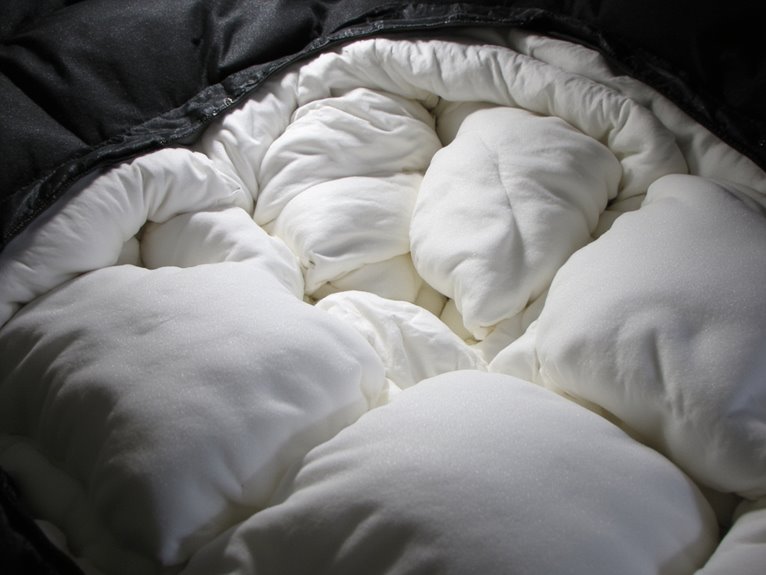
Material selection forms just one part of baffle performance—the geometric design and placement of these fabric chambers directly determines your sleeping bag’s ability to retain heat and maintain insulation loft.
Baffle effectiveness depends on how well these chambers prevent down migration and eliminate thermal bridges. Vertical V baffles maximize overlap, reducing conductive heat loss through direct pathways. Horizontal trapezoid baffles create stable 14:7 angles that maintain chamber integrity under compression.
Strategic baffle geometry prevents down migration and thermal bridging, with V-shaped and trapezoid designs maintaining insulation integrity under compression.
Proper baffle design keeps insulation closer to your body while preventing the chimney effect that allows warm air to escape.
- Draft tubes along zippers eliminate heat loss through seams and closures
- Chamber geometry controls down distribution ratios between top and bottom sections
- Overlap design prevents thermal bridging where compression creates cold spots
- Specialized neck baffles reduce heat loss through collar openings during movement
This insulation performance directly impacts your bag’s thermal efficiency rating. Poor baffle construction can compromise a bag’s ability to maintain its stated temperature ratings, even when using high-quality insulation materials.
Weight and Durability Considerations
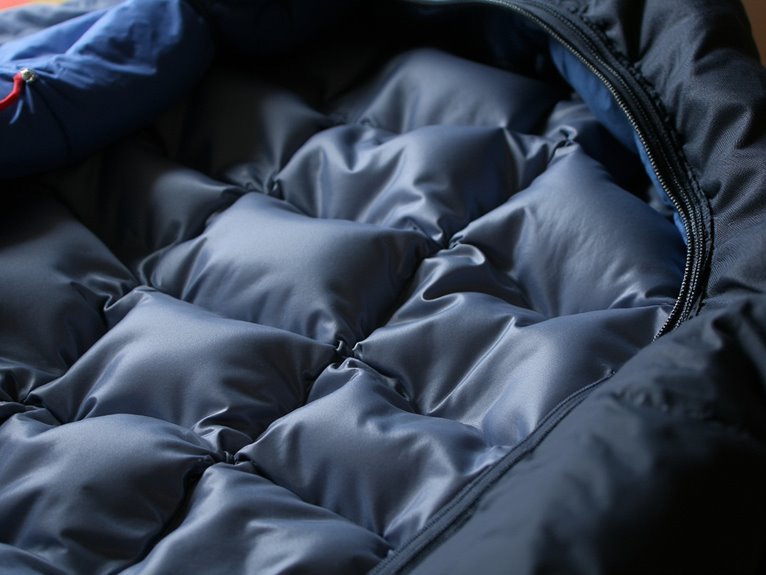
Every ounce matters when you’re carrying your shelter on multi-day expeditions, yet sacrificing durability for weight savings can leave you shivering in a damaged sleeping bag miles from civilization.
Ultralight bags under 1 pound prioritize minimal weight through 10-15D shell fabrics and streamlined baffle construction. However, these thin materials increase puncture risk and reduce longevity.
Down migration poses a significant threat to baffle insulation performance over time. Poorly constructed baffles allow fill to shift and pack in one area, creating cold spots. Box-wall baffles prevent this migration but add 2-4 ounces compared to sewn-through designs.
Material choices directly impact this tradeoff. Ultra-high-fill-power down (850+) maximizes warmth-to-weight ratio, while synthetic fills add 6-12 ounces but resist moisture damage that compromises baffle integrity.
Similarly, sleeping pad materials like 40D-50D nylon with TPU coating provide excellent tear resistance and waterproofing while maintaining reasonable weight for car camping applications.
Breathability and Moisture Management Features
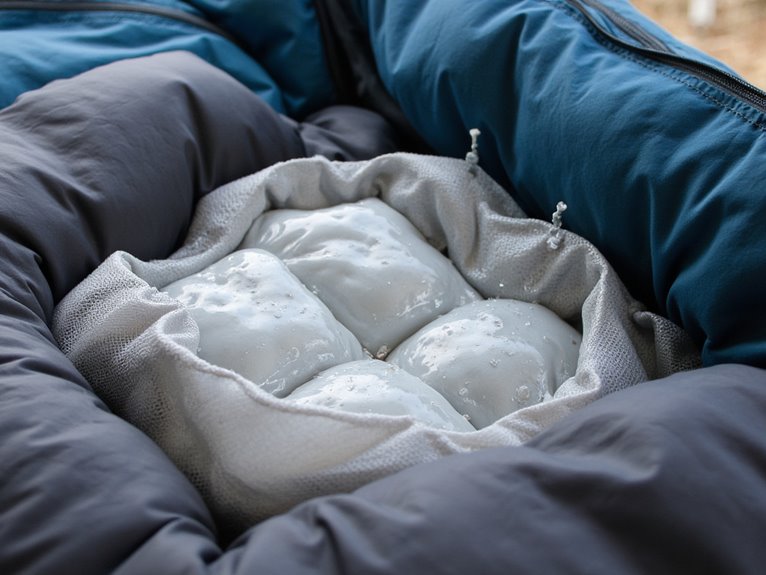
While weight and durability form the structural foundation of baffle performance, moisture becomes your sleeping bag’s silent enemy once you’re zipped inside.
Breathable membranes in modern sleeping bags actively transport vapor away from your body while blocking external moisture infiltration. These materials, typically featuring waterproof breathable PU coatings, maintain the delicate balance between protection and ventilation.
Moisture barriers work alongside baffles to prevent insulation dampening. DWR treatments on outer shells repel water while allowing internal vapor transmission.
Moisture-wicking linings enhance this system by pulling perspiration away from your skin.
Strategic baffling systems combined with draft collars create enhanced thermal zones that prevent warm air from escaping while maintaining optimal moisture regulation throughout the night.
- Synthetic insulations like PrimaLoft resist moisture damage better than down
- Vapor barrier liners prevent moisture transmission in extreme conditions
- Waterproof breathable shells protect against external moisture sources
- Condensation prevention requires proper ventilation and material selection
Cost Implications of Different Baffle Designs
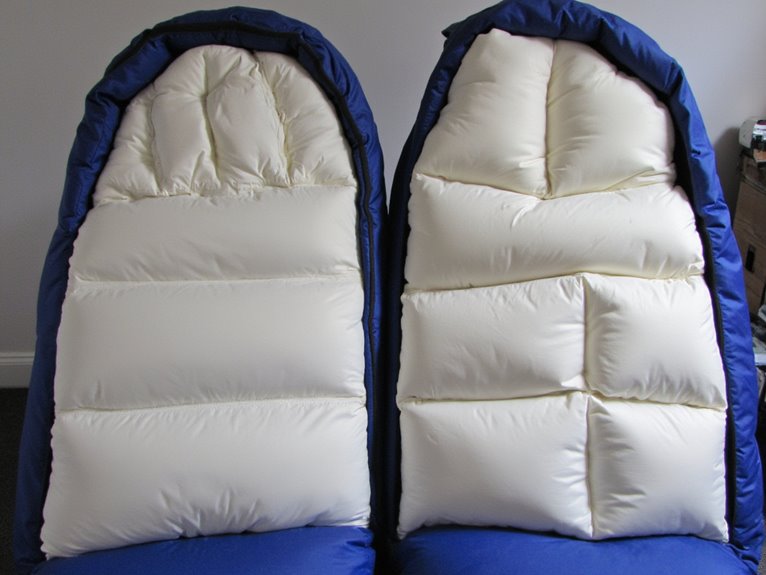
When you’re shopping for a sleeping bag, baffle design directly impacts the price you’ll pay at checkout. Box baffles deliver superior baffle efficiency but cost more due to complex construction requirements. Continuous baffles reduce manufacturing expenses yet compromise thermal performance through potential cold spots.
| Baffle Type | Price Range | Thermal Efficiency |
|---|---|---|
| Box Baffles | $300-600 | Excellent |
| Continuous | $150-300 | Good |
| Expansion | $400-700 | Superior |
| Sewn-Through | $100-250 | Fair |
| Modular | $500-800 | Excellent |
Premium down fill (700-950 fill power) considerably inflates costs. Lightweight materials designed for backpacking command higher prices due to specialized fabrics and precision sewing requirements. Entry-level bags use simpler baffling to target budget-conscious customers, while high-end models with advanced box baffling target serious outdoor enthusiasts willing to pay premium prices for maximum performance.
Choosing the Right Baffle System for Your Needs
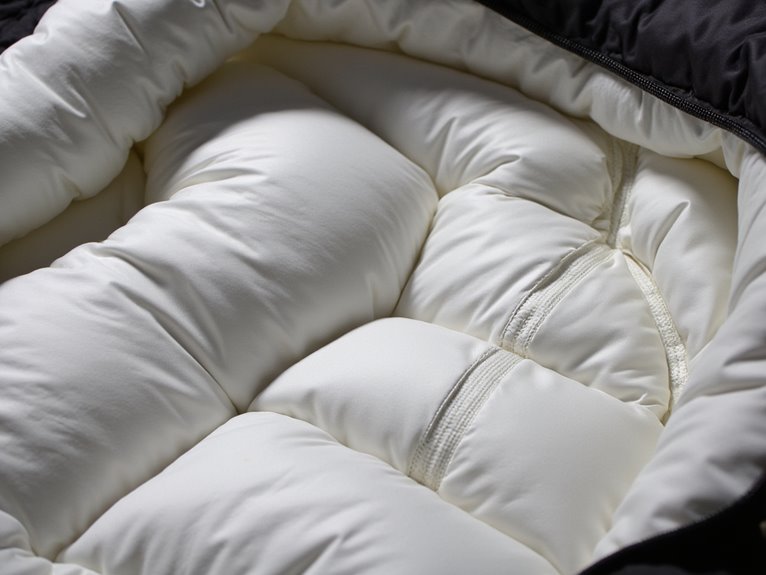
Understanding cost factors helps narrow your options, but selecting the ideal baffle system requires matching specific design features to your outdoor activities and environmental conditions.
Different baffle types serve distinct purposes based on temperature ranges and usage patterns. V-shaped baffles deliver superior insulation efficiency compared to traditional horizontal designs, making them ideal for cold-weather camping. Continuous baffle systems offer versatility for variable conditions but add complexity and weight.
Consider these factors when choosing your baffle system:
- Activity level: Backpackers need lightweight stitched-through construction, while car campers can handle heavier continuous systems
- Temperature range: Extreme cold requires double baffle systems with high fill power down
- Climate conditions: Humid environments benefit from moisture-resistant baffle materials
- Fill type compatibility: Synthetic insulation performs differently than down in various baffle configurations
Frequently Asked Questions
Can I Repair Damaged Baffles in My Sleeping Bag at Home?
You can repair damaged baffles using DIY techniques at home. Baffle repair requires lightweight ripstop nylon patches, strong polyester thread, and fabric glue.
First, extract insulation from damaged areas. Cut patches larger than tears. Sew reinforced stitches or apply seam sealer. Redistribute insulation evenly before closing repairs.
Work in dry conditions to prevent moisture entrapment. Professional repair is recommended for extensive damage.
Do Synthetic Insulation Sleeping Bags Use the Same Baffle Systems?
You won’t find the same baffle systems in synthetic sleeping bags. Synthetic insulation types like bonded fibers don’t require traditional baffle materials since they resist migration naturally.
Instead, you’ll see quilting or offset stitching techniques that secure the insulation without creating thermal chambers. These construction methods eliminate potential cold spots while reducing manufacturing complexity.
Synthetic bags rely on sheet insulation or panel arrangements rather than the compartmentalized baffle chambers essential for down insulation.
How Often Should I Redistribute Down Filling in My Baffled Sleeping Bag?
You should redistribute down filling in your baffled sleeping bag after each drying cycle and following extended storage periods.
For sleeping bag maintenance, check for clumping every 10-15 uses during active seasons.
The down filling frequency for redistribution depends on your baffle design—overstuffed compartments require less frequent attention.
Use your arms to smooth out clumps or run the bag through a dryer on low heat to restore proper loft distribution.
Are Sleeping Bag Baffles Affected by Altitude or Temperature Changes?
Temperature changes don’t physically alter your sleeping bag’s baffle structure, but they greatly impact baffle functionality.
Cold weather increases risks of insulation shifting and cold spots forming. Altitude has minimal direct effects on baffles themselves, though barometric pressure may slightly affect loft.
Combined cold and high-altitude conditions make effective baffle design more critical for maintaining insulation efficiency and preventing down migration throughout your bag.
Can Baffle Design Affect How Compact My Sleeping Bag Packs Down?
Yes, baffle construction considerably affects your sleeping bag’s packability.
Box baffles create superior insulation but add bulk and weight, resulting in larger packed sizes.
Stitched-through baffles compress smaller due to simpler construction and fewer materials.
Complex sidewall designs increase material thickness, reducing compressibility.
Your packing techniques must account for baffle volume—optimized baffle calculations balance insulation loft with compression needs for your intended use.
On a final note
You’ll find that baffle construction directly impacts your sleeping bag’s thermal efficiency and longevity. Boxwall baffles offer superior insulation but add weight and cost. Stitched-through designs provide durability at the expense of warmth retention. Consider your intended use: backpacking demands lightweight sewn-through construction, while car camping allows heavier boxwall systems. Evaluate fill power requirements, temperature ratings, and budget constraints. The right baffle system guarantees consistent loft distribution and eliminates cold spots.


